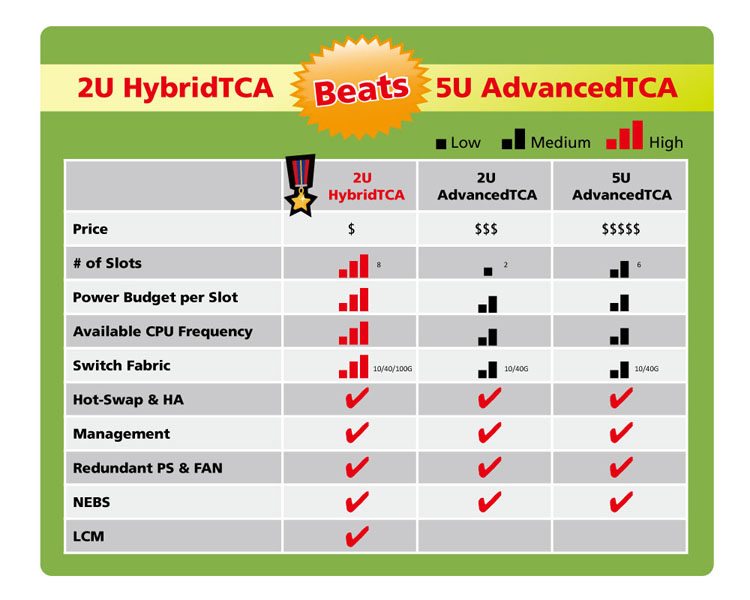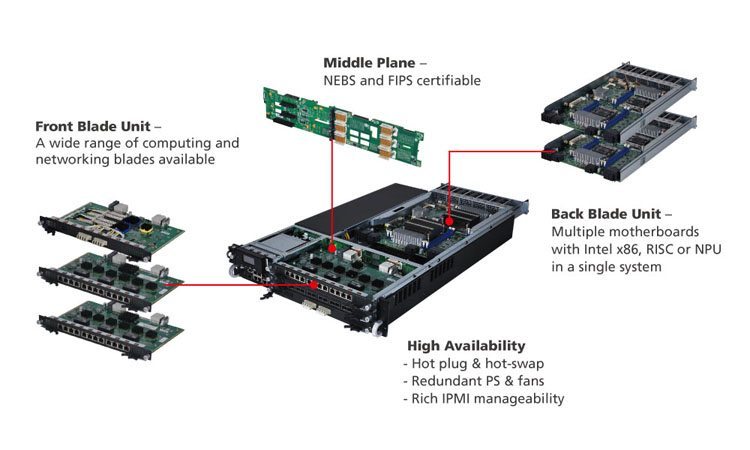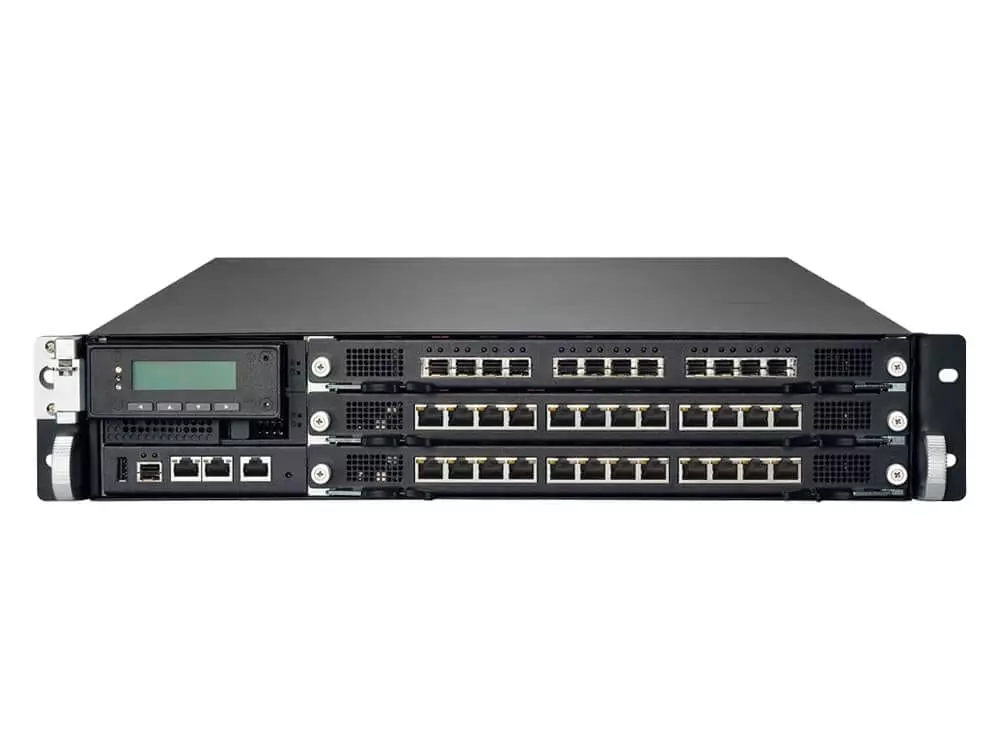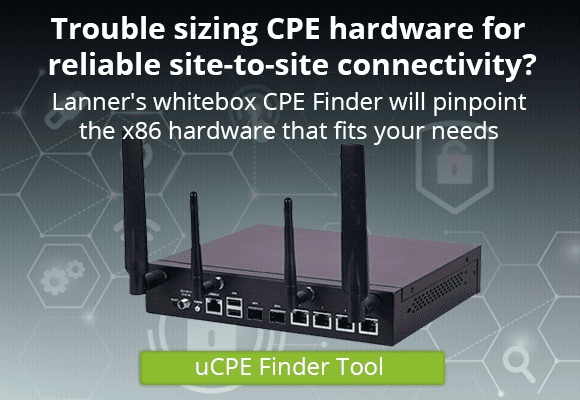 For years Lanner has been solving customers’ problems and fulfilling requests by adopting the latest technologies such as Crypto acceleration and DPI, with the aim of integrating more innovative features into our industry-leading hardware appliances; and doing so has in turn facilitated the development of a mutually beneficial synergy between Lanner and the internet security industry heavyweights.
For years Lanner has been solving customers’ problems and fulfilling requests by adopting the latest technologies such as Crypto acceleration and DPI, with the aim of integrating more innovative features into our industry-leading hardware appliances; and doing so has in turn facilitated the development of a mutually beneficial synergy between Lanner and the internet security industry heavyweights.
The Making of the HybridTCA™ Platform
In the early years, all Lanner manufactured network appliances were based on the Intel Architecture, given the availability of easy programming and rich resources around the Intel technology. Intel Architecture’s strength in computing power, however, was somewhat held back by its limited networking optimization, especially for handling small packets. In 2005, RMI and Cavium emerged as the two major players excelling at producing multicore Network Processors that were capable of handling small packets and integrating security accelerating engine for offloading the intensive calculation required by the encryption process; upon having received a number of requests from customers, Lanner began to focus on building appliances using RMI’s XLR processors and Cavium’s Octeon processors. However, even though such appliances were efficient in handling packets, they couldn’t meet the performance required for applications such as WAN optimization, application delivery and IPS or DDoS. The only solution therefore, was to combine both Intel Architecture and Network Processors in one appliance so that high power computing, management and both the control and the data planes can be seamlessly integrated.
In 2007 Lanner started developing the first Hybrid Architecture prototype, now known as the HybridTCA™, short for the Hybrid Telecommunications Computing Architecture. Integrated inside this single 2U appliance are one Intel Tylersburg dual CPU server board and one Cavium Octeon plus board, capable of delivering up to 100Gbps of firewall throughput. Moreover, this appliance is carrier-grade and NEBS ready, making it a perfect platform for cloud computing.
There are two notable success stories for Lanner’s HybridTCA architecture. The first saw the implementation of the HybridTCA hardware as a platform for application delivery and global load balancing while the second was for high-end data center security. Around 10K units of HybridTCA™ appliances have been shipped as of today, generating more than $2.5 billion of revenue for our customers.

The Advantages of HybridTCA™ Platform
Lanner HybridTCA™ platforms have advantages over the prevalent AdvancedTCA infrastructure in areas such as hardware design, customization options and cost/energy efficiency. Compared to the AdvancedTCA appliances, Lanner HybridTCA appliances are compact, reducing space required for deployment by up to 70%, making them a more flexible solution for a wider range of applications. Boards used in traditional AdvancedTCA systems are limited to the standard 200W power input while Lanner’s HybridTCA™ is customizable with basic X86 boards that support dual CPUs with 130W power input per CPU, giving it an edge over the AdvancedTCA in power consumption. Finally, HybridTCA’s front to back design for air flow facilitates better heat dissipation, and was implemented after countless hours of in-house thermal simulation.
Now let’s get a closer look at Lanner’s Hybrid Architecture for a better understanding of its advantages and for why it could consolidate all the technologies and functionalities.
The Modularized Architecture
Lanner HybridTCA™ takes the concept of modular design to the next level. The 3 major units, Middle Plane, Front Blade and Back Blade, on which its design concept is based make it easier for customers to configure settings per their specific needs.

Middle Plane
The brain of the HybridTCA platform is the Middle Plane because it connects everything together. The Middle Plane renders all cable connections unnecessary, making possible a cable-less design. The communication between the upper and the lower blades take place via PCI express, and the front blades are connected to those on the back through either PCI-express or XAUI interface, depending on which boards are used and how much throughputs are required. Designing the middle plane therefore is an ODM process that requires customization per customers’ requirements. All connectors used on the middle plane are ATCA grade for high speed interface and reliability.
Back Blade Unit
There are two blades on the back of the HybridTCA appliance. The lower board was originally designed for control and management but this design was soon retired because it demanded a lot of computing power. Instead the Intel Tylersburg platform was used for the same purpose. The upper board, on the other hand, was designed for data processing. It was based on FPGA or other RISC network service processors such as Tilera’s GX, Broadcom’s XLP, Cavium’s Octeon or Freescale’s QorIQ. The new design does not limit the upper board to data processing, it could just as well be another X86 board for redundancy or for building a high performance control and management plane with immense computing power. With Intel’s new DPDK and QuickAssist technology, we could simply use Intel Architecture for data purpose.
Front Blade Unit
There is a 3 levels FBU on the front of the HybridTCA appliance. All Ethernet interfaces go through the front blades; a maximum of three blades can be accommodated. Three standard Ethernet modules with PCI-Express interface are available for configuring 12 Gigabit RJ45 ports, 12 Gigabit fiber ports and 4 fiber 10G ports. A switch blade or even a data blade with RISC processors can also be used here for processing the packet forwarding and security. Found also on the front panel is a storage unit for three hot pluggable 3.5″ hard drives or six, also hot pluggable, 2.5″ hard drive or SSD disks.
The reliance on networking for human-machine interaction lays the foundation for the cloud-based IoT (Internet of Things) development. The increasing demand for security and traffic management will no doubt place Lanner’s HybridTCA in the forefront of telecommunications sector as the ideal solution that is energy, space and cost efficient.

